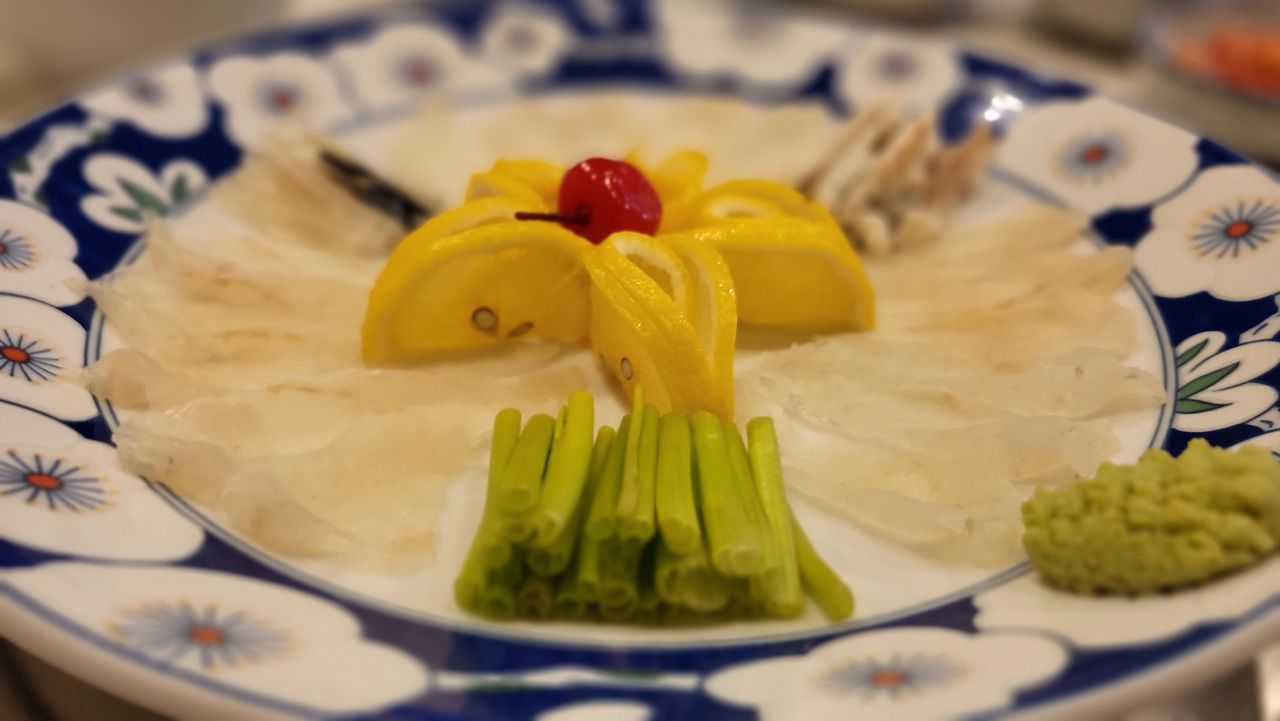 |
Blowfish sashimi (Kim Hae-yeon/The Korea Herald) |
Blowfish, also known as puffer fish, is undeniably one of the top winter delicacies.
The clean, light taste of the fish meat with its unique chewy texture stands out among other types of edible fish.
Rich in essential amino acid taurine, blowfish is known to help with blood circulation and warm up the body. It does not contain neutral fat, which can help with weight loss and protects healthy skin. The blowfish skin has abundant selenium, a source studied to have anti-cancer effects.
Called "bok" in Korean, there are over 10 different types of blowfish, but the common ones caught in Korea appear to have white bellies and dark gray backs with black dots.
When threatened, bok instantly inflates itself and turns into the form of a round-shaped ball to scare away predators.
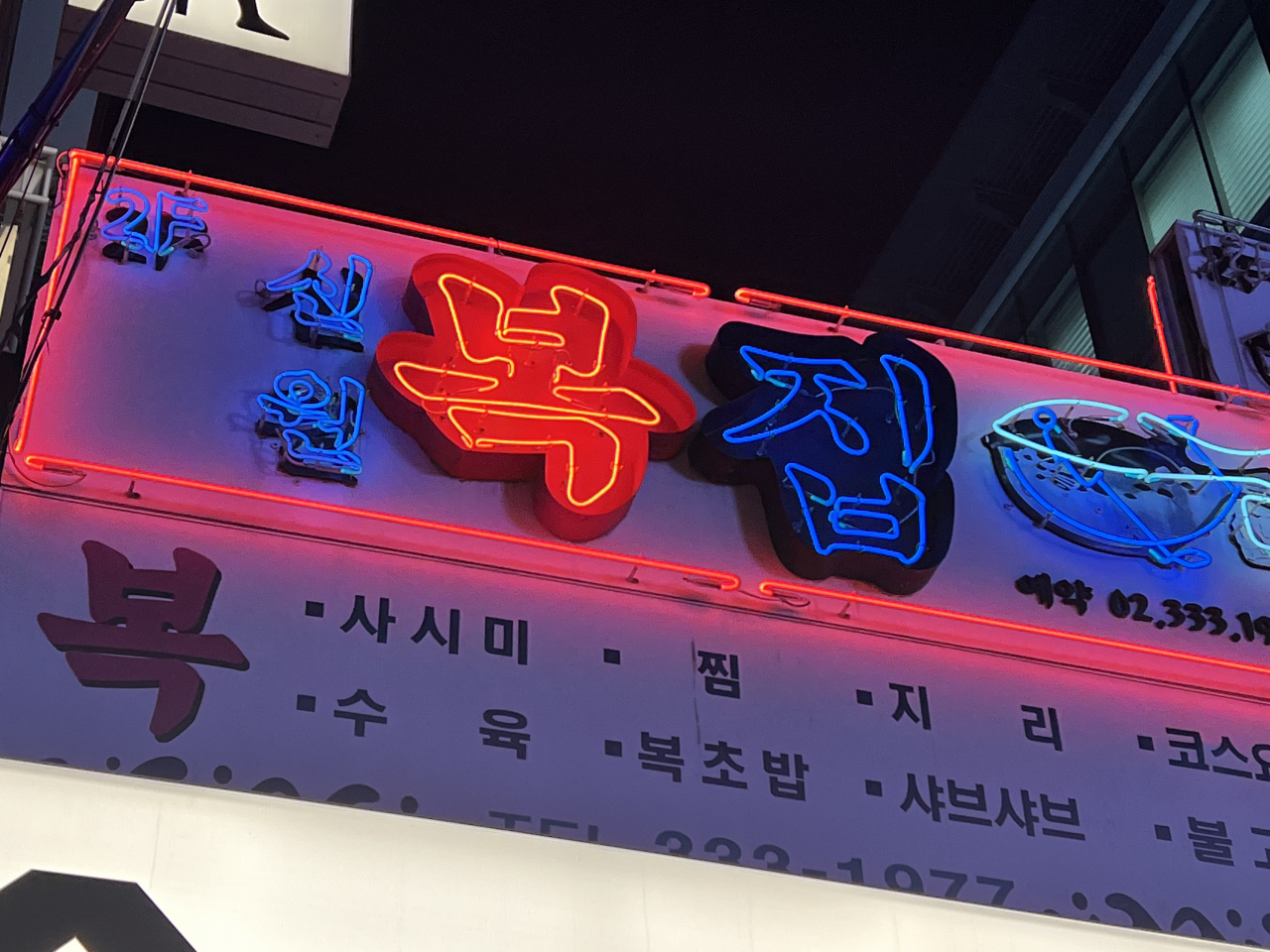 |
Sinwon Bokjip, a blowfish specialty restaurant located in Hongdae, central Seoul (Kim Hae-yeon/The Korea Herald) |
But contrary to their intention, self-inflation is not the real threat.
Some blowfish contain tetrodotoxin, a type of toxin that when consumed, can lead to extreme difficulty in breathing and can paralyze one's body, ultimately resulting in death just several hours later. Historical archives show that countless people have died while consuming bok during the Joseon era, although this seldom happens today.
Therefore, in Korea, only trained chefs with special licenses can cook bok in restaurants.
Blowfish dishes can be enjoyed year-round in bok restaurants, but why are they the most popular during the winter season? The ones caught from December to early February tend to have less or weakened toxicity, and the flesh becomes full, which makes its chewy and succulent texture the best time to consume.
Boktang, blowfish soup
Sinwon Bokjip, located in a Hongdae alley in Seoul, has been in the same place since 1983, serving customers for nearly 40 years.
Many public figures have been patrons of the restaurant, including former President Kim Dae-jung and first lady Lee Hee-ho, who lived nearby, as told by the restaurant's owner.
Boktang, boiled blowfish soup, also called bokguk, is one of the must-try signature dishes for first-time visitors and frequenters alike, at Sinwon Bokjip.
Generous portions of bright green minari are served in the hot pot, which give the broth its clean flavor. The fleshy blowfish makes one dare to think that it is worth the try despite the danger.
 |
Boktang, blowfish soup (Kim Hae-yeon/The Korea Herald) |
Try the light taste of the soup first, then go ahead with the blowfish, by gently dipping some into the special soy sauce offered.
Those who favor drinking can easily grasp why Koreans have them as “hangover soup,” since they are neither too salty nor heavy but still possess a delicate earthy flavor.
Regular blowfish soup costs 29,000 won per person, and the one with chambok, a specific type of blowfish known to be of higher quality, at 90,000 won.
Bokbulgogi, pan-fried marinated blowfish
The flavor of bokbulgogi varies by the head chef at bok restaurants, having their unique seasonings and spices mixed on the fish meat.
Bokbulgogi comes out seasoned and served on a hot grill pan.
Bokbulgogi at Sinwon Bokjip has a brownish red hue due to gochujang and red peppers used in the seasoning, but it falls on the less spicier side compared to other bok restaurants.
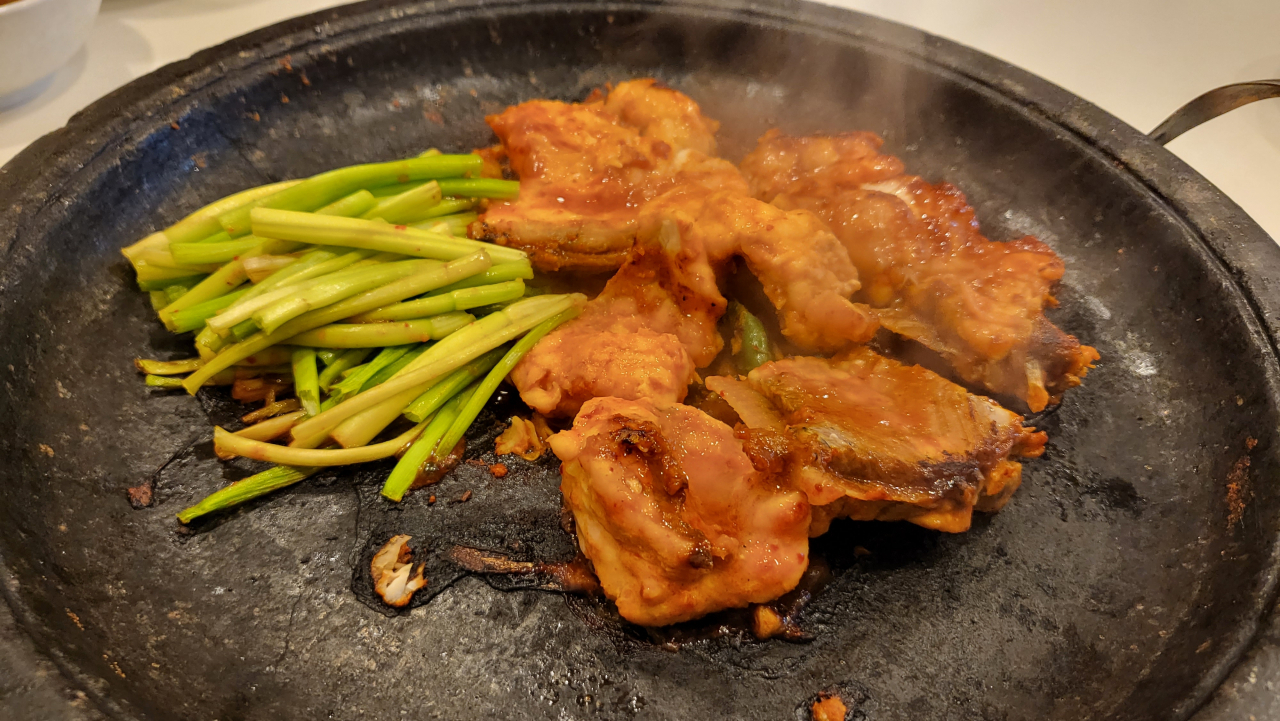 |
Bokbulgogi, pan-fried marinated blowfish (Kim Hae-yeon/The Korea Herald) |
A nicely grilled bokbugogi should be crunchy on the outside and chewy on the inside. A cup of warm hire sake of which grilled chambok fins are boiled together, is highly recommended to accompany the dish.
A set of side dishes that consist of bean sprouts, spinach, burdock and briefly boiled blowfish skin salad, is offered to be enjoyed and eaten together.
One can order a separate bowl of white rice with a savory piece of bokbulgogi on top. Bokbulgogi is priced at 65,000 won per person.
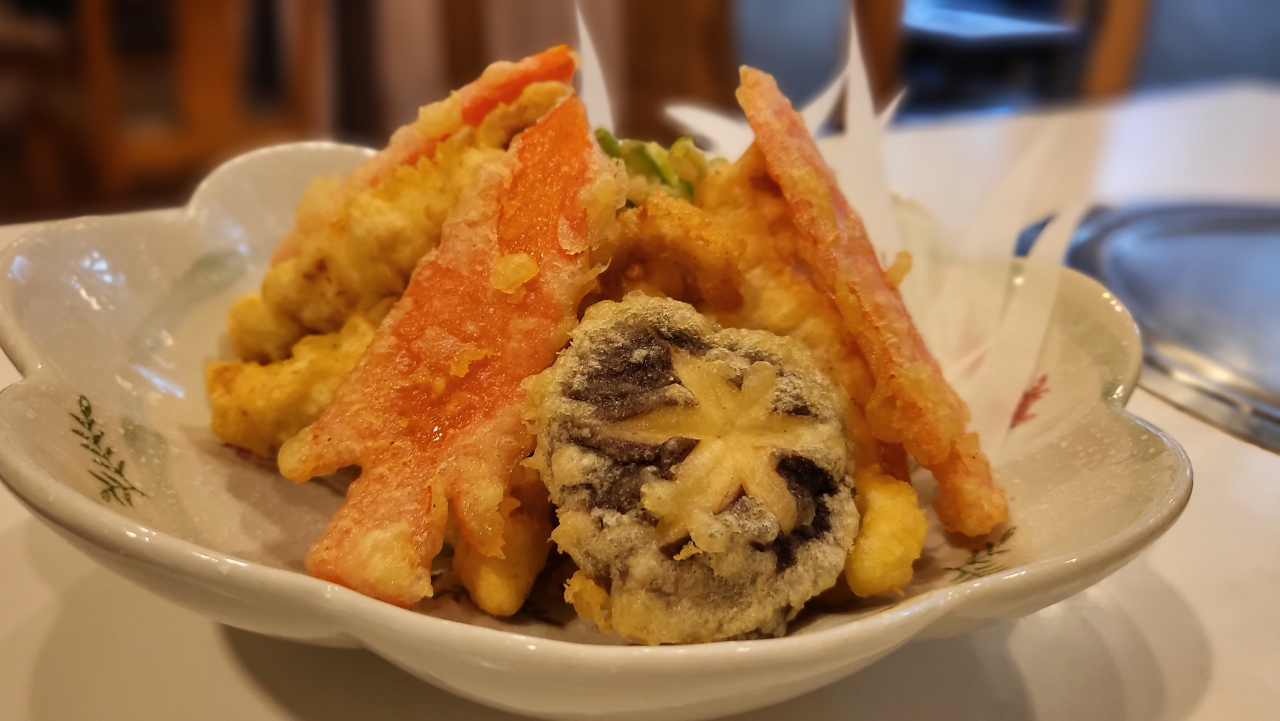 |
Deep-fried blowfish and vegetables (Kim Hae-yeon/The Korea Herald) |
Fried blowfish and sashimi
The two menu items -- fried blowfish (boktwigim) and sashimi (bokhoe) -- are usually ordered as side dishes, accompanied by a main meal such as boktang, bokbulgogi, bokjjim or bok-shabushabu.
A dish of fried blowfish consists of fried fish in a crispy golden batter and some other deep-fried vegetables including shiitake mushrooms, carrots and minari.
One can try the fried fish with or without soy sauce.
Bok sashimi is served on a wide plate, and consists of thin slices of raw blowfish, some lightly boiled blowfish meat, blanched blowfish skin, minari stems and slices of lemon.
Squeeze the lemon juice on top of the raw fish slices and place a slice of raw meat on your plate. Put a slice or two of boiled fish meat and blanched fish skin. Lay some minari stems on top, and fold the raw fish slice over to make it into a roll. Gently dip it into the restaurant's own citrus ponzu sauce and enjoy.
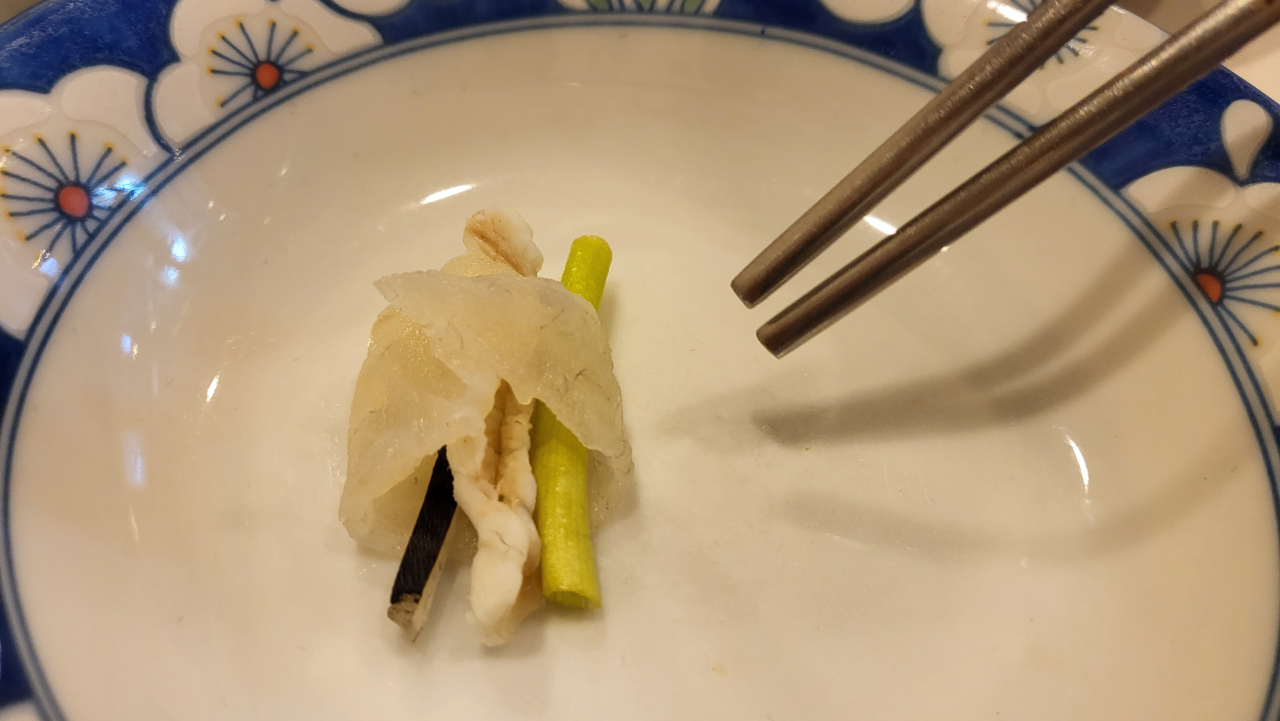 |
Chef's recommended way of enjoying blowfish sashimi (Kim Hae-yeon/The Korea Herald) |
A medium-sized dish of fried blowfish, enough for two to three people, costs 59,000 won. A plate of bok sashimi is priced at 129,000 won.







